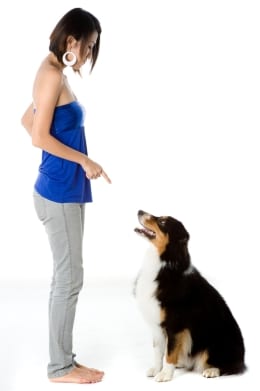When is the “Pay up Pooch!” technique used?
The “Pay up Pooch!” technique is used to control boisterous and attention seeking behavior in dogs and to gently reward them for following your leadership.
You dog may be manipulating you by:-
-
Nuzzling, barking, or pawing your for a pat
-
Jumping up, mouthing or biting you
-
Barking at your door to get in
-
Barking at your door to get out
-
Begging for food
-
And in many other ways you could mention!

For this we often use the Laser Lock Sit as a definable end point.
Why is it important?
The technique is important if your dog has a bold, boisterous or manipulative behaviors.
If you allow such behaviour to continue, your dog is being allowed to assert its control over you and is reinforcing its leadership over your behaviour. That’s not good.
This could lead to problems such as:-
- Development of aggression
- Worsening attention-seeking behaviour
- Unruly and often destructive behaviours
- Overprotective behaviour
The “Pay up Pooch!” technique should be used by anyone whose dog is aggressive or that continually demands attention.


What are the main features of the technique?
The technique is simple. Whenever your dog wants anything, it should PAY UP for what it wants.
Usually the payment is a response to some form of command you may give. The most useful command is ‘SIT’ followed by ‘LOOK’ (at you).
If you were consulting with me we would use the more elaborate cognitive therapy process called the Leave Routine.
Try this simple process where your TARGET is to get the dog to SIT for 5 seconds, whereupon you will reward your dog for that TARGET behaviour.
STEP 1
Your dog seeks attention (e.g.mouths you for attention) – your reaction is to:
- Not give it attention and either
- Look away or
Preferably turn or twist away from the dog
(This process is called ‘negative punishement’ because it removes what your dogs wants to weaken its attention-seeking behaviour.
That is much better than ‘positive punishment’ which is where you add something unpleasant, such as yelling or hitting, to weaken the attention-seeking behavior. I am sure you can see positive punishment is not good.
STEP 2
- After you turn away – immediately command SIT.
- Does your dog respond?
- If YES turn and face it and look at it for 5 seconds but say nothing while your dog maintains its SIT.
- Then reward, usually with a gentle whisper and an over-exagerrated smile (we call that the ‘Jim Carrey’ smile!).
- Generally it’s better not to pat at this point as that often makes your dog break its SIT
- Now get the dog to COME to you as you walk off and Command SIT again.
- Now repeat step 3 – 4 say five times. If you do that Pulse of five, say 10 times per day (which is easy) that’s 50 times per day your dog is taught to be your follower.
- That make 350 times per week!
If the dog continues, then use the Time Out technique (refer to the Attention Seeking Pet Pick or use the search function to find that) to stop the attention-seeking.
Comments
Look for the many opportunities each day where your dog is ‘pushing you around’ and where you can use the “Pay up Pooch!” technique.

The more you win, the happier the dog will be because it’s getting the attention it wanted BUT for following your lead and not for leading you.
Also, for no reason at all, several times a day give your dog a command it must obey, just to practice your command control, your leadership and your ‘Jim Carey Smile’.
Don’t forget obedience training. It is one of the best ways to gently gain leadership over a dog. Also enrich your dog’s life-style with some ‘brain fodder’ and exercise.
